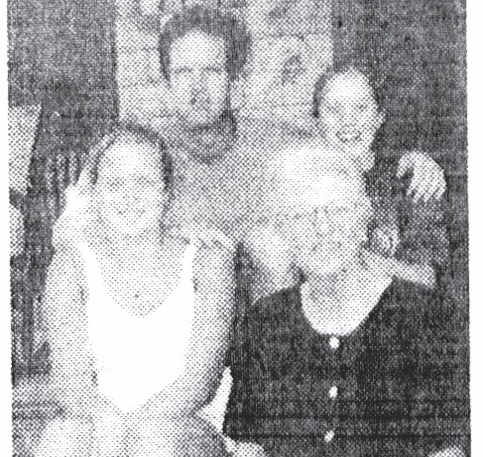I’M JUST CURIOUS: Just have fun!
/0 Comments/in I’m Just Curious/by Debbie Walker by Debbie Walker
by Debbie Walker
Just for fun seemed like a nice change for a New Year, I hope you agree. This is going to be multiple choice commercial jingle trivia test: (underline or circle)
“Double your ________, double your fun!”
Leisure – pleasure – treasure
“Juicy Fruit is gonna move ya! It’s got a taste that _______ right through ya!”
Gets – moves – hits
“Kiss a little longer, stay close a little longer,________ a little longer, longer with Big Red!”
hold hands – make out – hold tight
“If I were an ________, everyone would be in love with me!”
Oscar Mayer hot dog – Oscar Meyer Wiener – Oscar Meyer Sausage
“The best part of _______is Folgers in you cup.”
Waking up – getting up – perking up
“I’d like to buy the world a Coke and keep it ________.”
Nice & clean – company – in harmony
“Be a _______, drink Dr Pepper.”
little better – winner – Pepper
“Plop, plop, fizz, fizz, oh what a ______”
Help it is – joy it is – relief it is
“Two all beef patties, special sauce, ________, cheese, ________onions on a sesame seed bun.”
Lettuce, pickles – lettuce, tomato – pickles, lettuce
“Have it your way, have it your way at ________.”
Taco Bell – Burger King – Wendy’s
“Ace is the place with the ________.”
Helpful hardware man – handy hardware man – helping hardware man
“See the U.S.A. in your _______.”
Buick – Ford – Chevrolet
“Put a tiger in your tank.”
Frosted flakes – ESSO – Little Debbie Snack Cakes
“Silly rabbit, ________ are for kids.”
Oreo’s – Cheerios – Trix
“I don’t want to grow up, I’m a ____ ___ _____ kid.”
Sears – Walmart – Toy’s R Us
“American Express: Don’t leave _______ without it.”
Home – New York – Work
The answers will be as follows. See how you do:
“Double your”- pleasure
“Juicy Fruit”- gets
“Kiss a little”- hold tight
“Big Red”- hold tight
“Oscar Mayer” – Wiener
“Folger’s” – waking up
“Coke”- company
“Dr Pepper”- pepper
“Alka seltzer”- relief it is
Two all beef – lettuce – pickles
“Your way” – Burger King
ACE – helpful
U.S.A. – Chevrolet
Tiger – ESSO
Rabbit – Trix
“grow up”__ Toy’s R Us
“American Express’ – home
As usual I AM JUST CURIOUS how you did with our little test. Contact me with questions or comments at dwdaffy@yahoo.com. Thank you for reading!!
REVIEW POTPOURRI – Respighi: Fountains of Rome; Pines of Rome
/0 Comments/in Review Potpourri/by Peter Catesby Peter Cates
Respighi: Fountains of Rome/Pines of Rome
Franz Andre conducting the Belgian National Radio Orchestra; Telefunken TC-8002, vinyl budget-priced LP from the late 1950s.
For people starting to listen to classical music, I would more readily recommend the Respighi Pines and Fountains of Rome over most Beethoven and Brahms Symphonies. These two pieces have the most colorful sounds, the loveliest strands of melody, and a very vivid sense of location.
The fountains are four spread around the historical city and musically evoked at different times of day, while four different rows of Rome’s magnificent pine trees are treated the same. The Fountains were premiered in 1916 during World War I, while the Pines received their debut in 1924. Both demand extraordinary virtuosity from a full symphony orchestra but have become immensely popular, receiving numerous recordings since then.
I have several different ones but, for some mysterious reason, was particularly drawn to Franz Andre (1893-1975), who was arguably the most prominent and busiest conductor in Belgium’s cultural life for almost 40 years, yet not that well-known in the United States. He delivered exceptionally exciting renditions that stand alongside those of Arturo Toscanini, Fritz Reiner, Eugene Ormandy Riccardo Muti, Seiji Ozawa, to mention a few. Several of Andre’s recordings of other works can be heard on YouTube but not the Respighis. However, E-bay and other vendors have copies of the LP for sale.
Some facts about the composer, Ottorino Respighi (1879-1956) – He had a fascination with languages as well as music and collected dictionaries.
He took piano under his father’s tutelage but was quite undisciplined in his habits. However, his father was startled one day to find his son playing the very difficult piano work, Symphonic Etudes, with total mastery.
He suffered from narcolepsy and would suddenly and frequently fall asleep.
He married one of his composition students in 1919 when she was 25 and he was 40. She outlived him by 60 years and died at 102, in 1996.
PAGES IN TIME – South China’s Summer Colony: The Bolt Hole
/2 Comments/in Pages in Time/by Website Editor
Lee Hargadon, front, joined her son Geoff, back, and his daughters Ashley, left, and Stephanie. (The Town Line file photos)
Reprinted from August 9, 1997
by Dorothy Templeton
The Leaning Elm cottage boasts one delightful addition called “the Bolt Hole.” Barbara Jones Haskins describes its construction: “My daughter Lee and her family spent several years in Colombia, South America. When they returned and came back to the cottage, Lee’s five children and her husband, plus my husband and I, all stayed in a cottage with partitions like tissue paper. An architect friend drew up a plan for an addition for privacy, with a bedroom, bath and kitchen space. Lee’s sons Geoff and Bob, teenagers (15 and 13 respectively) at the time, helped with the construction.”
Lee Hargadon takes up the story: “It was to be a glorified bedroom. They worked on it the summer of ‘69 with Ralph Austin. In South America, Spanish had become their primary language, so that’s what the boys used to talk together. It was frustrating for Ralph: he didn’t have a clue as to what was being said.”
“We were paid 30 cents an hour,” Geoff (visiting for two weeks with daughters Ashley and Stephanie) recalls, “and I hated getting up early in the morning. Someone put in the supports and we all did the sawing. It took all summer, nine to four, with Saturdays and Sundays off. We couldn’t get to swim when we wanted to.” The Bolt Hole (so dubbed by visiting English cousins because one could “bolt away” to it), is connected to the cottage by a short wooden walkway, provides a delightful escape, is of good size, high-roofed, with a window wall overlooking the lake.“We always spend all winter thinking how we will get back to South China,” Barbara admits. “People from the colony are scattered from coast to coast. But when we return here, we pick up relationships as though we’d been all year together. Hugh Weed’s mother and aunt lived ion the front of the inn at one time and Ella would walk down and visit me. (Hugh’s parents, Hazekiah and Ella, were the second of Wilmot Sr.’s friends to build a cottage, in 1900).”
A sense of timelessness prevails on the porch of the Leaning Elm. Bird song, wind in the trees, voices from nearby cottages blend. Nobody hurries, their activities repeating those of a century ago. The porch steps where the family has gathered to eat watermelon must have witnessed this event countless times. Lee insists, “The steps are crucial to family life at the cottage. We drink our morning coffee sitting on them, eat a luncheon sandwich there, have an afternoon drink, watch the kids water ski, and sun set.” It’s also a spot from which to greet a neighbor who is walking along the waterfront path to another’s cottage and make a quick plan for later in the day.
Memories of Lee’s father, Wilmot Rufus Jones Jr., flow and enhance our porch conversation. He owned a thistle class sailboat which he named Do It. Lee recalls, “In the days when he was planning our annual expedition to Pemaquid Point, he would always buy the lobsters steaming hot at the pound in New Harbor, which is now Shaw’s, and take them to eat over on the rocks. During World War II, when gas rationing was on, we would come up on the East Wind train from Wilmington, Delaware, straight through to Augusta, and we’d give our gas stamps to Ralph Austin (who was our caretaker and handyman) to pick us up.”
Later, as Lee’s five children were growing up, she remembers that there always seemed to be others the right age (and sometimes friends they brought from home) for tennis, swimming, boating, water skiing, and lots of card playing. Someone always had a boat to share for water skiing, so taking turns at it and watching others from the raft consumed many afternoons.
Now, on this breezy day, Ashley, 14, and Stephanie, 12, have plans to go sailing with their grandmother (Lee) in the small boat that spends winters in the boathouse at the water’s edge – waiting for their return. When Stephanie reports in parting, “This is a great place to see relatives, relax and have fun.” Ashley comments. “It’s also a great place to watch sunsets.”
Stephanie then shares a poem she wrote, inspired by happy summers in South China.
The Leaning Elm, South China
by Stephanie Hargadon
My favorite place in Maine my be
The Leaning Elm cottage in South China, you see.
All the rainy days around the fire, reading,
Playing cards at the table, eating,
Long walks around the water’s surface,
Fun and relaxation must be South China’s purpose.
Waking up late, seeing neighbors at late hours,
Swimming, making cookies and picking flowers,
My favorite place in Maine for me
Is South China, yes, South China, it just might be.
GROWING YOUR BUSINESS: Finding and hiring the right people
/0 Comments/in Growing Your Business/by Dan Beaulieu
 by Dan Beaulieu
by Dan Beaulieu
Business consultant
Owners of businesses both large and small tell me that the biggest challenge they are facing today is finding, hiring and keeping good people. Unemployment in our state as well as all over the country is at record lows. It seems that everyone who wants a job has one already. It is bad in Seattle where I go to work with a company every month, that one company started giving away new Tesla’s for any new hire who stays a year.
Electronics companies in Chicago are stealing one another’s employees so often that war has been declared and companies are suing each other.
The same is true for the companies here in our area. So, with that in mind, here are a few tips on how to hire and keep the right people in your company:
- Know who you’re looking for: Develop a good job description of the position you are trying to fill. The more detailed you can be about the position the better it will be. Include overall responsibilities, daily duties, qualifications, compensation package, and any special requirements.
- Show them the future: Don’t offer prospective employees a job, offer them a career or at least training in your business. Show them how they will learn valuable skills that will make them more valuable in the future. No matter what your business is, there is always something to be learned. Show your prospective employees the bigger picture, the future of working with your company, even if your company will be a stepping stone to a greater career in the future.
- Offer security: If the person is a bit older show them how if they do a good job, they will be able to count on a solid job as long a s they need one.
- Offer training: No matter what your business, you can teach someone how to do it. Remember, the fact that you own your business puts you in a special category in terms of your experience making you a perfect candidate to act as a mentor/teacher to your employees
- Hire for passion: Look for passion first. Even if the person knows nothing about your business. You can teach the business, you cannot teach passion
- Hire slowly and fire quickly. Take your time when hiring the person, (even if you don’t have much time) it will be worth the extra effort you make to not only completely vet the candidate but also spend time with him or her to make sure of the right fit. There is such a thing as company culture, and you have to make sure that the candidate will fit into that culture. And in the end even if you have done everything correctly once the person is hired, if you see that it is not working, then do yourself and that person a favor and let him or her go weekly. And believe me you will know pretty quickly.
- Respect: Respect your team. Show them the courtesy that you want to receive yourself. Be fair and honest and open with them and they will follow you through thick and thin. Next time we’ll talk about team building, another great way to grow your company.
FOR YOUR HEALTH: How People With Low Vision Can Stay Safe And Independent
/1 Comment/in For Your Health/by Website Editor (NAPSI)—People with low vision have blind spots that can make it difficult or impossible to drive, read or see faces. These impairments cannot be corrected by surgery or glasses. What’s more, too many are blind to the realization that much can be done to improve their quality of life.
(NAPSI)—People with low vision have blind spots that can make it difficult or impossible to drive, read or see faces. These impairments cannot be corrected by surgery or glasses. What’s more, too many are blind to the realization that much can be done to improve their quality of life.
What Can Be Done
In fact, low vision rehabilitation services help people make the most of the vision they have. The first step is to get an eye exam by an ophthalmologist, a physician who specializes in medical and surgical eye care.
Who Can Help
An ophthalmologist can determine the full extent of vision loss and exact location of blind spots. Either the ophthalmologist or a low vision specialist can then determine the best techniques and devices that can help you get around your individual challenges.
Where EyeCare America Comes In
If you’re concerned about the cost of the exam, the American Academy of Ophthalmology’s EyeCare America program may be able to help. This national public service program provides eye care through volunteer ophthalmologists for eligible seniors 65 and older; and those at increased risk for eye disease. As one EyeCare America patient said, “I’m a senior living on a low income. It had been 30 years since I’d had an eye exam. It was a true blessing to receive this service.”
Low Vision Services Offer Hope
The field of vision rehabilitation has advanced significantly over the years, offering more effective technologies and strategies. Today, ophthalmologists’ solutions range from simple, portable video magnifiers to enlarge text and objects to high-tech glasses with cameras that let people read text and see faces.
In addition, there are many simple changes people can make on their own to help them live better:
- Improve contrast. Contrasting colors can make it easier to accomplish household tasks and improve safety. Put dark place mats under white place settings, get area rugs that are a contrasting color with the floor and kitchen towels and cutting boards that contrast with the counter top. Use contrasting colored tape along the edges of rugs, stair steps and lamp shades.
- Improve lighting. Every year, about three million older Americans are treated for injuries from falls, according to the Centers for Disease Control and Prevention. Many of these falls are caused by low vision. Add lighting to staircases and dark hallways. Remove rugs from hallways to prevent tripping. Task lighting in the kitchen can make food preparation safer and easier.
- Reduce clutter and organize. A cluttered house is more difficult to navigate and can contribute to falls and frustration. When each item has a specific place and is identified with a high-contrast label, it’s easier to locate items needed for everyday living.
- Embrace technology. Books on tape and personal voice-activated assistants, such as Google Home or Amazon’s Alexa, can be enormously helpful for people who can no longer see well enough to read, dial a phone or set a thermostat. With a simple voice command, these can phone dial a friend for you while the thermostat dials up the heat.
While there isn’t one strategy or tool that works for every person, vision rehabilitation offers hope for many and can help people stay in their homes and continue doing the things they love.
Learn More
For more facts and tips, visit www.eyecareamerica.org. To see if you or someone you care for is eligible for the EyeCare America program, visit www.aao.org/eyecareamerica.
SCORES & OUTDOORS: Raccoons: wives tales, myths and facts
/0 Comments/in Scores & Outdoors/by Roland D. Hallee by Roland D. Hallee
by Roland D. Hallee
On our way home to Waterville from Augusta last Sunday, my wife and I observed a raccoon walking along the roadside in Winslow. My first thought: “A raccoon out during the day is not normal, and could mean it is rabid.”
While it is true that a rabid raccoon will exhibit a variety of unusual behaviors, activity during daytime is most definitely not a guaranteed indicator of rabies. You see, although raccoons are primarily noctural, they do often get some stuff done during the day. It’s not that unusual for a raccoon to be active in the middle of the day. We just don’t see it often. They often go off in search of food or drink, especially a nursing female raccoon who has babies to take care of, and who have extra nutritional requirements.
Raccoons, along with foxes, skunks and bats are considered a primary carrier of the rabies virus in the United States. While any warm-blooded animal can carry rabies, these are the ones that are called “rabies vector species.”
According to the Centers for Disease Control and Prevention (CDC), only one human has ever died from the raccoon strain of rabies. That is because a rabid raccoon is usually dead within 1-3 days of becoming infected, and even if you’re bitten by a rabid raccoon, effective post-exposure treatment is available and recommended.
How can you tell if a raccoon has rabies? Rabid raccoons are very sick, mostly they are lethargic. Their walk may be erratic, or their legs paralyzed. They may be walking in circles or falling over, discharging from the eyes or mouth, or lurching in an unnatural fashion. In short, they just plain look sick. If you see a raccoon outside when it’s light out, and it looks agile, alert, is running or foraging in a smooth and coordinated manner, then you can be almost certain that it doesn’t have rabies. This doesn’t mean you should approach it and offer it a lick of your ice cream cone, but you most likely have nothing to worry about.
But the best advice is that should you see a raccoon, no matter what time of day, leave it alone. Never try to feed it or approach it. A raccoon out during the day may be foraging for food. For example, especially in urban locations, if you always put your trash out at 1 p.m. in the afternoon, raccoons will learn that. So, if you see one that is lingering in your yard, seems overly friendly, is acting unstable, etc., leave it alone, and contact your police or animal control officer.
- A couple of myths about raccoons is that if a raccoon is seen during the daylight hours, it is rabid. Well, we’ve already discussed that, and the answer is “no.”
- Raccoons hibernate during the winter: No, they go through a period of decreased activity in the winter.
- All raccoons are carriers of rabies: No, the majority of them do not have rabies but those that do, will die within days of being infected.
- Raccoons eat cats: No, they don’t – usually. Raccoons are quite capable of killing cats but normally don’t attack cats unless they are threatened or rabid.
- Raccoons always wash their food: No, it is more akin to their “feeling” their food.
- Raccoons make good pets: No, raccoons do not make good pets. Even though it is legal to keep wild animals in Maine including raccoons – with a permit – it’s not advisable to have a raccoon as a pet. Over time, as it grows older, it could become too wild to handle.
Raccoons in general can be a nuisance, but caution should always be used around them. I once had one living under my garage. I set a Hav-a-Hart trap baited with cat food, and captured it within an hour and a half. But the tricky part was moving it to another location in the country. Frightened, it because very aggressive while in the cage, and I had to use a stick, with gloves on, in order to load it in the back of my truck. Its claws are as sharp as razors and could have done some major damage to my hands when I tried to grab the handle. The release was successful, and the raccoon hurriedly waddled away. I don’t recommend this to just anyone.
A very safe rule of thumb, quite simply, is if you see a raccoon, leave it alone, or contact a professional if you suspect that it is rabid.
Roland’s trivia question of the week:
Of the eight remaining teams in the NFL playoffs, Minnesota, San Francisco, Tennessee, Baltimore, Houston, Kansas City, Seattle and Green Bay, which team was the most recent Super Bowl winner?
SOLON & BEYOND: Taking a peak at past columns
/0 Comments/in Solon & Beyond/by Marilyn Rogers-Bull by Marilyn Rogers-Bull & Percy
by Marilyn Rogers-Bull & Percy
grams29@tds.net
Solon, Maine 04979
Good morning, dear friends. Don’t worry, be happy!
This morning I sit here at my contrary computer with crossed fingers and a prayer that it will cooperate with me today! This is Monday, January 6, 2020, and after reading our daily Morning Sentinel paper of January 4, with the headline on the front page saying; “Sentinel to debut digital-only Mondays; Cost-saving measure to preserve newsroom jobs starting March 2.”; I was shocked to say the least! Anyway it had got me thinking of how much many things had changed in all the years I have been writing a column in the many papers over the years. The above information was written by J. Craig Anderson, of the Portland Press Herald…for those who didn’t see it, it goes on to say; “Four daily newspapers in Maine, including the Morning Sentinel, will cease production of their Monday print editions as of March 2 in a cost-cutting move to preserve newsroom jobs, according to their CEO.”
I admit to being, “Old Fashioned,” and believe me I know that many of the values of yester-year are long gone!….but now that I have reached the ripe old age of 90, I find some things beyond my understanding! The thing about that change, is what will some of the older folks do for their news if they don’t have a computer?
History is very important to me, and so I got out some of the old papers I had written for in the past. The following is taken from a Skowhegan Reporter, Skowhegan, Maine, Nov. 3, 1988. My column was headed by lots of hearts, (12) and the words, “The friendliest town in the state” SOLON. Had told a couple of people I’d probably have to leave town after last week’s Reporter came out and one of them commented on Friday that it was well written but he said, ” You know most people probably read it and just laughed.” Oh yes, I’m sure of that (that’s what I’m here for is to give everyone a good laugh). Can’t remember what worthy cause I might have been standing up for at that time.) But this dreamer’s heart can’t help dreaming that maybe a seed of thought was planted in a few minds. This column went on to say, Do you remember last winter when someone sent one of my columns to President Ronald Reagan? Well, the other day I had a letter from him, no mention of the article but it starts out on a real friendly note, Dear Marilyn,” he goes on to tell what his goals were etc., and I quote, “It’s our responsibility, yours and mine, as a beacon of freedom and liberty for the world.”
Another one of the Somerset Reporters, this one Thursday, Nov. 19, 1987, “Somerset County’s paper since 1840,” and below the name it has these words: “Better is the fear of the Lord than great treasure and trouble therewith.” Proverbs 15:16. Across the top of the weekly paper it says: “Hometown news from Skowhegan, Madison, Bingham, Moscow, Athens, Cornville, Madison, Anson, North Anson, Solon, Canaan, Mercer, Norridgewock and more. In the corner it says Somerset County’s Largest Weekly Newspaper.
One of the front page stories in the above paper is as follows: “Today’s the day smokers are urged to “but out.” What started as an upbeat, good natured effort to encourage smokers to give up cigarettes for 24-hours, is now considered a successful campaign to get puffers to quit the habit – for good.
It’s the annual “Great American Smokout Day” today, November 19, in cooperation with the American Cancer Society and hospitals throughout the Central Maine area. (I’m wondering how many of you who are reading the above can remember that day…and did you quit?)
And now for Percy’s memoirs: When things seem hopeless, trust God and do what’s right. First think: God is on my side! He wants to help me. Second say: “I will rejoice and be patient through this hopeless situation.” Next pray: ask God to help you trust in him. Finally obey: patiently wait for God to work things out. God always keeps his promises, so you can depend on him to help you. That little piece of paper has been sitting here for days, don’t know who wrote it.
Also from Percy, to make you laugh, from that little book I was telling you about: …Great Minds Discuss Ideas, Average Minds Discuss Events…Small Minds Discuss People.
Give Us Your Best Shot! for Thursday, January 9, 2020
/0 Comments/in Give Us Your Best Shot!/by Website EditorTo submit a photo for this section, please visit our contact page or email us at townline@fairpoint.net!
THE MONEY MINUTE – Pensions: Do I take the lump sum or monthly payment?
/0 Comments/in The Money Minute/by Jac Arbour
 by Jac M. Arbour CFP®, ChFC®, President
by Jac M. Arbour CFP®, ChFC®, President
J.M. Arbour Wealth Management
For those of you who need to choose a pension payout option, you might agree that the task can seem confusing. In this month’s article, I will share eight key considerations when making this decision.
Terms of the Lump Sum: One must compare the amount of the lump sum to the value of the payments over an estimated period of time (life expectancy). Many people are tempted to take the lump sum, but it is important to note that this may not always be the best choice.
Interest Rates: In low interest rate environments (like right now), the higher the lump sum payout is likely to be. Once the tides turn, so will the lump sum amount.
Life Expectancy: If you have medical issues and do not have longevity, a lump sum may be the best choice. On the flip side, someone who might live well into their 90s could be a strong candidate for the pension payments.
Financial Stability: If the plan sponsor is weak, the lump sum looks more attractive. People often mention the backing of the PBGC, but with its own financial problems, the PBGC may not have the ability or the legal obligation to insure your full amount.
Market Risk: Once a person takes the lump sum, the risk (totally) and performance (somewhat) are in your hands. You will want to consider what type of income you can create with the lump sum and its relativity to the pension payout amounts.
Taxation: You can rollover the lump sum to an IRA, but monthly pension payments you cannot. Therefore, your desire for tax deferral is something to consider.
Habits: Are you the type to spend money if you have access to it or are you a saver and investor? The person with financial discipline will likely prove to be the better person to receive a lump sum.
Beneficiaries: Many people feel as though they have more flexibility to pass money to their heirs by taking the lump sum. If you have a spouse or heirs, the above considerations apply to them as well.
Here is what I promise: All you can do is make the best decision with the information you have. Therefore, it is your job to get all the information before making the decision.
See you all next month.
Jac Arbour CFP®, ChFC®
Jac Arbour is the President of J.M. Arbour Wealth Management and can be reached at 207-248-6767.
Investment advisory services are offered through Foundations Investment Advisors, LLC, an SEC registered investment adviser.
Interesting links
Here are some interesting links for you! Enjoy your stay :)Site Map
- Issue for May 2, 2024
- Issue for April 25, 2024
- Issue for April 18, 2024
- Issue for April 11, 2024
- Issue for April 4, 2024
- Issue for March 28, 2024
- Issue for March 21, 2024
- Issue for March 14, 2024
- Issue for March 7, 2024
- Issue for February 29, 2024
- Issue for February 22, 2024
- Issue for February 15, 2024
- Issue for February 8, 2024
- Issue for February 1, 2024
- Issue for January 25, 2024
- Issue for January 18, 2024
- Issue for January 11, 2024
- Issue for January 4, 2024
- Issue for December 21, 2023
- Issue for December 14, 2023
- Issue for December 7, 2023
- Sections
- Our Town’s Services
- Classifieds
- About Us
- Original Columnists
- Community Commentary
- The Best View
- Eric’s Tech Talk
- The Frugal Mainer
- Garden Works
- Give Us Your Best Shot!
- Growing Your Business
- INside the OUTside
- I’m Just Curious
- Maine Memories
- Mary Grow’s community reporting
- Messing About in the Maine Woods
- The Money Minute
- Pages in Time
- Review Potpourri
- Scores & Outdoors
- Small Space Gardening
- Student Writers’ Program
- Solon & Beyond
- Tim’s Tunes
- Veterans Corner
- Donate










